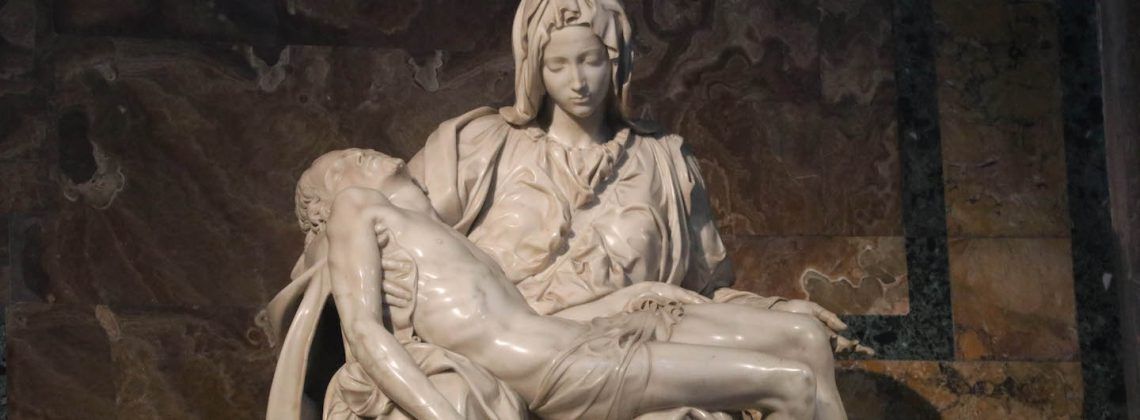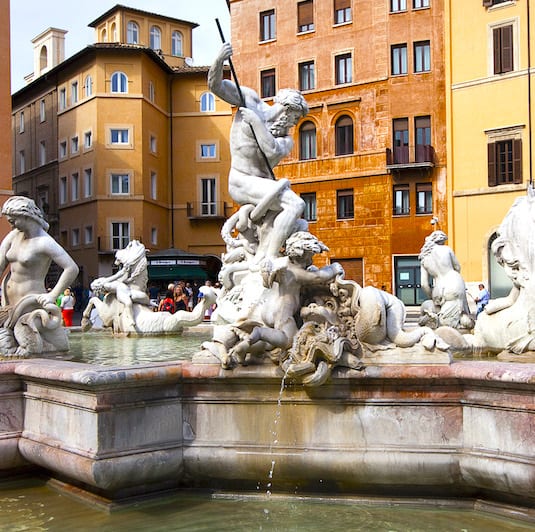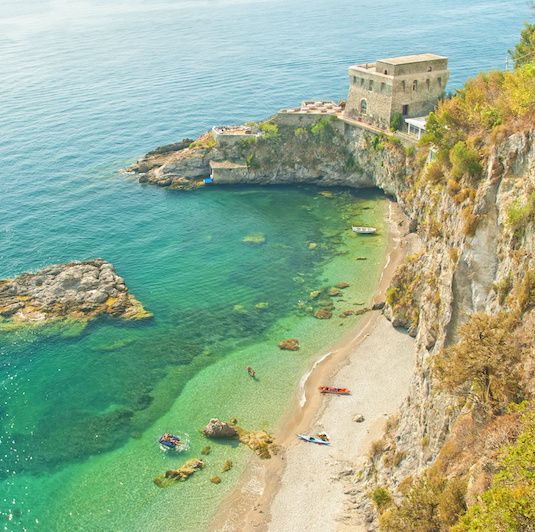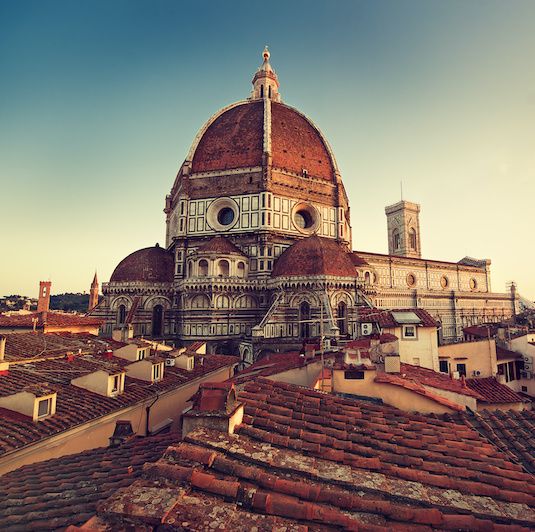Visitors to Vatican City may be surprised to find that there are actually two lines to look out for: one for the Vatican Museums, and one for St. Peter’s Basilica. Home to 54 galleries, the Vatican Museums house some of the world’s most precious artwork. The largest church in the world, St. Peter’s Basilica features many iconic works of art, including Michelangelo’s La Pietà. La Pietà, or “The Piety” is considered by many art historians to be one of the world’s most famous sculptures.
Michelangelo’s La Pieta
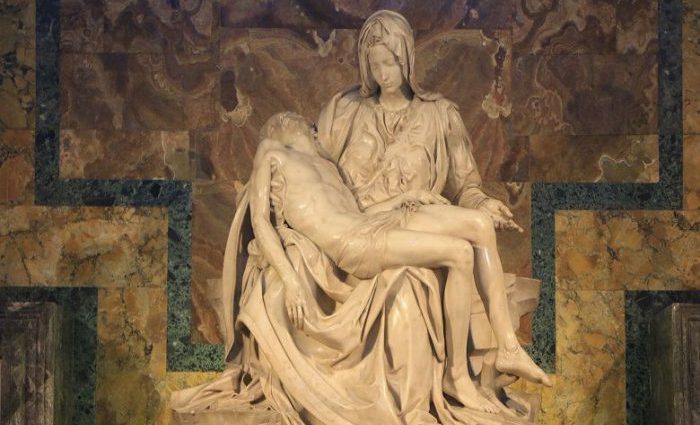
The History of La Pietà
Renaissance artist Michelangelo spent the years 1498-1499 sculpting La Pietà. He would go on to sculpt the David and The Sistine Chapel ceiling in the following years. French Cardinal Jean de Bilhères-Lagraulas commissioned Michelangelo to carve La Pietà in 1497.
The scene depicts the Virgin Mary holding Jesus Christ, her son, after being taken down from the cross. Jesus is held lifeless by his mother in an incredibly emotional moment for the Virgin Mary and any on-lookers. Religion aside, the compassion for Mary, mother of Jesus, holding her deceased son is intense. Michelangelo sculpted the scene in a vivid manner that not only is impressive in terms of detail, but his ability to create emotional scenography is matched by few.
The sculpture is carved from a block of high-quality Carrara marble and is the only one of Michelangelo’s works that he signed.
Why is it Named La Pieta and What does that Mean?
Pieta in Italian means piety. Therefore La Pieta translates to “the piety”. That said, the words are used slightly differently in native Italian. The idea of the phrase points towards sadness and compassion from an emotional perspective. Specifically the duty of Mary as both mother and an icon.
Why did Michelangelo name it this? For starters, he did not name it La Pieta. When biblical art is commissioned it is taken directly from popular or less popular biblical scenes. When Cardinal Bilhères-Laraulas asked Michelangelo to sculpt this masterpiece he would have asked him to make a “la pieta.”
In fact, while it is the most famous without a doubt, Michelangelo most definitely was not the first to sculpt this scene. The oldest version I personally found is from the Church of St. Panteleimon in Gorno Nerezi which is in Macedonia. I have little doubts that the Gorno Nerezi version was the first-ever either.
Popular Vatican Tours
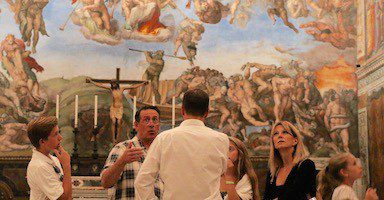
Best Selling Tour
Privileged Entrance Vatican Tour with Sistine Chapel
This our most popular and longest-running Vatican tour to date. It enters the Vatican City & Museums an hour before the public opening and visits the Sistine Chapel as it opens. Admissions are included and our English-speaking guides do a wonderful job bringing the museums to life! Admissions included.
See Prices
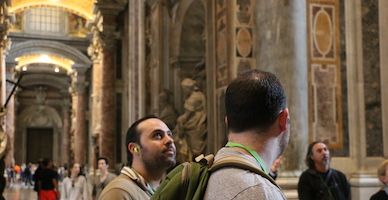
Best Price!
Skip the Line Vatican Tour with Sistine Chapel & St. Peter’s Basilica
One of our most popular Vatican tours since it is such an amazing value. Skip the line to get inside with a super-knowledgeable English-speaking guide that will bring the museum to life. Stories of the artists, popes, conspiracy, love, and of course tragedy! Admissions included.
See Prices
What makes La Pietà so special?
Michelangelo took great care in sculpting La Pietà’s elaborate detail from a simple block of marble. Even more impressive, Michelangelo finished the sculpture in a year. Michelangelo designed La Pietà with a pyramidal structure in mind. Mary’s head serves as the vertex of the pyramid and the statue gradually widens to its base. Most notably, Michelangelo portrayed a young and beautiful Mary as opposed to traditional depictions of an older Mary grieving over Jesus.
La Pietà made headlines in 1972 when a man jumped over a rail in the basilica and damaged the sculpture using a hammer. His repeated blows to the sculpture severed Mary’s entire arm and severely damaged her eyelids and nose. The sculpture was eventually restored and returned to St. Peter’s Basilica after a long and arduous process. A large bulletproof glass shield now protects La Pietà.
La Pietà Fun Facts
The Only Work Signed by Michelangelo
Of all of Michelangelo’s famous works of art, La Pietà is the only one that he signed. Michelangelo’s engraved signature is etched into Mary’s chest.
La Pietà Traveled to New York
La Pietà was featured at the 1964 World’s Fair in New York. The statue was shipped overseas protected by a 4,900-pound plexiglass case.
A radio transmitter inside of La Pietà’s crate served as a tracking device for if the ship carrying the sculpture across the Atlantic Ocean were to sink.
Virgin Mary’s Delicate Eyelid
The Virgin Mary’s eyelid was the hardest part of the statue to repair after its 1972 attack. 20 attempts were needed to make the eyelid presentable to the public.
Popular Rome Tours
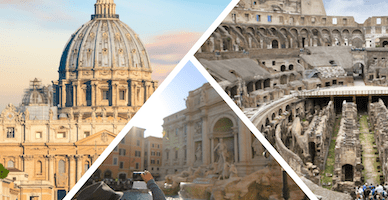
Best Selling Tour
Rome in a Day Tour with Colosseum and Vatican Museums
The best way to get your bearings all in one day. Visit the Sistine Chapel, Colosseum, Trevi Fountain, and more with a licensed and fun English-speaking tour guide. They’ll add tons of insights and make the entire experience so much more memorable. Also, you’ll get a feel for the city so it’s great on one of your first days in the city. All admissions and transport included although there will be a lot of walking.
See Prices

Best Price!
Skip the Line Vatican Tour with Sistine Chapel & St. Peter’s Basilica
One of our most popular Vatican tours since it is such an amazing value. Skip the line to get inside with a super-knowledgeable English-speaking guide that will bring the museum to life. Stories of the artists, popes, conspiracy, love, and of course tragedy! Admissions included.
See Prices
Here is Where to Stay in the Most Popular Destinations
Rome, Florence, Venice, and the Amalfi Coast & Capri
I Want More Italy!
- Check out our YouTube video and step-by-step guide about how to do Rome in a Day. If you’d rather let us guide you, check out our Rome tours.
- Not sure where to stay in Rome? Read this guide!
Follow our adventures in Italy on Facebook, Instagram, and YouTube. Then, comment and tell us what you want us to cover next.
